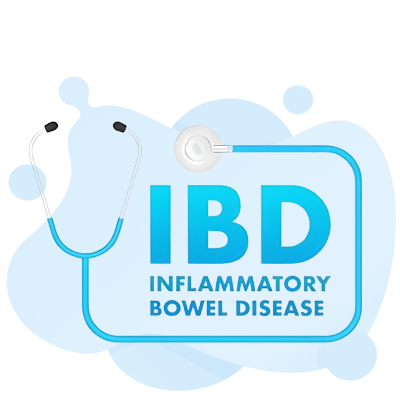IBD Test Guide: Understand Your Diagnosis

Welcome to our comprehensive guide on understanding the various testing options available for diagnosing Inflammatory Bowel Disease (IBD). If you suspect you may have IBD or if you have been experiencing symptoms such as abdominal pain, diarrhea, or rectal bleeding, it is essential to seek a proper diagnosis. In this guide, we will explore the different screening methods and diagnostic tests that can help healthcare professionals accurately identify IBD and develop an appropriate treatment plan.
Diagnosing IBD involves a combination of factors, including a thorough analysis of your medical history, physical examinations, and various laboratory and imaging tests. By understanding the purpose and benefits of these tests, you can gain valuable insights into your condition and make informed decisions about your healthcare.
Free IBD Practice Test Online
Key Takeaways:
- IBD Test Guide provides comprehensive information on various testing options for diagnosing Inflammatory Bowel Disease (IBD).
- Screening methods and diagnostic tests play a crucial role in accurately identifying IBD and developing an appropriate treatment plan.
- Understanding the purpose and benefits of these tests can help individuals make informed decisions about their healthcare.
- If you experience symptoms such as abdominal pain, diarrhea, or rectal bleeding, it is essential to seek a proper diagnosis for early intervention and management of IBD.
- Consulting with a healthcare professional is crucial to determine the most appropriate testing options for your specific situation.
Common IBD Symptoms and Risk Factors
Before considering the various testing options for diagnosing Inflammatory Bowel Disease (IBD), it is crucial to be familiar with the common symptoms and risk factors associated with this condition. Recognizing these signs can help you determine when it is essential to undergo testing for a potential diagnosis.
Common Symptoms of IBD
IBD encompasses different conditions such as Crohn’s disease and ulcerative colitis, both of which exhibit similar symptoms. The following are common indications of IBD:
- Abdominal pain and cramping
- Diarrhea that may be bloody
- Unexplained weight loss
- Fatigue and weakness
- Loss of appetite
- Frequent bowel movements
- Rectal bleeding
If you are experiencing any of these symptoms persistently, it is crucial to consult with a healthcare professional for further evaluation.
Risk Factors for IBD
While the exact cause of IBD is unknown, certain risk factors can increase the likelihood of developing the condition. These risk factors include:
- Family history of IBD
- Age (most commonly diagnosed between the ages of 15 and 35)
- Gender (slightly higher prevalence in men for Crohn’s disease and women for ulcerative colitis)
- Ethnicity (higher incidence in Caucasians and people of Ashkenazi Jewish descent)
- Smoking
It is important to note that having these risk factors does not guarantee the development of IBD, but it may contribute to an increased susceptibility.
As presented in the research by Scott and colleagues on “Screening for Crohn’s disease and Ulcerative colitis from symptoms and risk factors: A systematic review onwards,” engaging in regular Crohn’s disease screening and ulcerative colitis diagnosis is essential for individuals experiencing these symptoms and having risk factors associated with IBD. Early detection and appropriate treatment can significantly improve the outcomes for individuals with IBD.
| Symptoms | Risk Factors |
|---|---|
| Abdominal pain and cramping | Family history of IBD |
| Diarrhea that may be bloody | Age (most commonly diagnosed between the ages of 15 and 35) |
| Unexplained weight loss | Gender (slightly higher prevalence in men for Crohn’s disease and women for ulcerative colitis) |
| Fatigue and weakness | Ethnicity (higher incidence in Caucasians and people of Ashkenazi Jewish descent) |
| Loss of appetite | Smoking |
| Frequent bowel movements | |
| Rectal bleeding |

Non-Invasive IBD Testing Methods
When it comes to diagnosing Inflammatory Bowel Disease (IBD), there are non-invasive testing methods that can provide valuable insights without the need for invasive procedures. These tests are commonly used to screen for IBD and involve analyzing blood or stool samples to detect biomarkers or genetic markers associated with the condition.
One non-invasive testing method is the IBD blood test. By analyzing a blood sample, this test can identify specific antibodies or proteins that are often present in individuals with IBD. The IBD blood test can provide valuable information about the presence and severity of the disease, helping healthcare professionals make an accurate diagnosis.
Another non-invasive option is the IBD stool test. This test examines stool samples for the presence of inflammatory markers, such as calprotectin or lactoferrin, which can indicate intestinal inflammation. The IBD stool test is a convenient and effective way to assess the activity of IBD and track its progression over time.
Genetic testing is also utilized in the non-invasive diagnosis of IBD. By examining an individual’s genetic makeup, healthcare professionals can identify certain gene variations associated with an increased risk of developing IBD. This information can help determine the likelihood of developing the disease and guide treatment decisions.
Furthermore, biomarker testing plays a crucial role in the non-invasive detection of IBD. Biomarkers are substances or indicators present in the body that can provide insights into the presence or progression of a disease. In the case of IBD, biomarker tests can measure specific molecules, such as C-reactive protein (CRP) or erythrocyte sedimentation rate (ESR), that are often elevated in individuals with active inflammation.
Benefits of Non-Invasive IBD Testing Methods:
- Non-invasive: Blood and stool samples are easy to collect, making these tests convenient and less invasive than other diagnostic methods.
- Early detection: Non-invasive testing can detect IBD in its early stages, allowing for early intervention and a better prognosis.
- Tracking disease activity: Non-invasive tests provide valuable information about the activity and progression of IBD, enabling healthcare professionals to monitor the effectiveness of treatment.
- Less discomfort: Non-invasive tests are generally more comfortable for patients, resulting in minimal discomfort during the diagnostic process.
While non-invasive testing methods are effective screening tools for IBD, it’s important to note that they may not provide a definitive diagnosis. In some cases, further invasive testing methods, such as colonoscopy or GI panels, may be required for a more conclusive assessment.
By leveraging non-invasive IBD testing methods, healthcare professionals can gather important information about the presence and severity of the disease. This allows for timely interventions and personalized treatment plans tailored to the individual’s specific needs. If you suspect you may have IBD or are at risk, consulting with a healthcare professional can guide you towards the appropriate non-invasive testing options.
Invasive IBD Testing Methods
When non-invasive tests indicate the presence of Inflammatory Bowel Disease (IBD) or if further diagnostic confirmation is needed, invasive testing methods may be recommended. These procedures provide more detailed information about the condition of the digestive system and help healthcare professionals make an accurate diagnosis. In this section, we will discuss two common invasive testing methods: colonoscopy and GI panels.
Colonoscopy for IBD
Colonoscopy is a commonly used procedure for diagnosing and monitoring IBD. During a colonoscopy, a flexible tube called a colonoscope is inserted into the rectum to examine the lining of the colon and the last part of the small intestine. This allows doctors to visually inspect the digestive tract and identify any signs of inflammation, ulcers, or other abnormalities.
Colonoscopy is considered the gold standard for diagnosing IBD because it provides a direct visualization of the inflamed areas. It allows for biopsy samples to be taken, which can be further analyzed to confirm the diagnosis and determine the specific type of IBD, such as Crohn’s disease or ulcerative colitis.
GI Panel Test for IBD
In addition to colonoscopy, a GI panel can be used to provide a comprehensive assessment of IBD. A GI panel is a specialized blood test that analyzes various markers associated with gastrointestinal conditions, including IBD. These markers can include genetic factors, inflammation indicators, and immune system responses.
The GI panel test for IBD can help healthcare professionals evaluate the severity of the disease, track its progression, and guide treatment decisions. By assessing multiple markers simultaneously, the GI panel provides a more comprehensive understanding of the patient’s condition.
| Testing Method | Advantages | Limitations |
|---|---|---|
| Colonoscopy |
|
|
| GI Panel Test |
|
|
Both colonoscopy and GI panel tests play crucial roles in the diagnosis and management of IBD. While colonoscopy offers direct visualization and the potential for biopsy, the GI panel provides a broader assessment of various markers. Depending on the patient’s symptoms and medical history, healthcare professionals may recommend one or both of these invasive testing methods to ensure an accurate diagnosis and effective treatment plan.
IBD Testing Options: Pros and Cons
When it comes to diagnosing Inflammatory Bowel Disease (IBD), there are several testing options available. Each method has its own set of advantages and limitations, which we will explore in this section. By understanding the pros and cons of each approach, you can make an informed decision about which test or combination of tests is most suitable for your situation.
Non-Invasive Testing Methods
Non-invasive testing methods offer a less invasive and more convenient approach to screening for IBD. These tests typically involve analyzing blood or stool samples to detect specific biomarkers or genetic markers associated with Inflammatory Bowel Disease.
- IBD Blood Test: This test measures certain markers in your blood that may indicate the presence of IBD. It is relatively simple and can provide valuable information about inflammation levels in your body.
- IBD Stool Test: By analyzing your stool sample, this test can detect the presence of specific markers that may indicate IBD. It is non-invasive, making it a convenient option for initial screening.
- IBD Genetic Testing: This test examines your genetic profile to identify any genetic variations associated with IBD. It can help determine your risk of developing the disease and aid in personalized treatment decisions.
- IBD Biomarker Test: Biomarker tests analyze specific substances in your body that may indicate the presence of IBD. These tests are often used in combination with other diagnostic tools to provide a more accurate diagnosis.

Invasive Testing Methods
Invasive testing methods may be recommended when further diagnostic confirmation is required or non-invasive tests suggest the presence of IBD. These procedures provide more detailed information about the condition of the digestive system.
- Colonoscopy: A colonoscopy involves inserting a thin tube with a camera into the rectum to examine the entire colon. This procedure allows doctors to visualize any inflammation, ulcers, or other abnormalities in the digestive tract.
- GI Panel: A GI panel combines several tests to provide a comprehensive evaluation of the gastrointestinal system. It may include endoscopy, biopsy, imaging tests, or other procedures to gather detailed information about the extent and severity of IBD.
It’s important to note that while invasive tests can provide more definitive results, they may be more uncomfortable and carry a slight risk of complications. The decision to undergo invasive testing should be made based on the recommendations of your healthcare provider and the specific needs of your situation.
By evaluating the pros and cons of both non-invasive and invasive testing methods, you can work with your healthcare team to determine the most appropriate approach for diagnosing IBD. The ultimate goal is to ensure an accurate diagnosis and develop an effective treatment plan tailored to your individual needs.
Comparison of IBD Testing Options
| Testing Method | Advantages | Limitations |
|---|---|---|
| IBD Blood Test | – Non-invasive and convenient | – May not provide a definitive diagnosis – False-positive or false-negative results possible |
| IBD Stool Test | – Non-invasive and easy to perform | – Limited accuracy, especially in early stages of the disease – False-positive or false-negative results possible |
| IBD Genetic Testing | – Can help determine genetic predisposition – Personalized treatment decisions possible | – Limited to identifying specific genetic variations – Does not provide a definitive diagnosis on its own |
| IBD Biomarker Test | – Can be used in combination with other tests – Enhances diagnostic accuracy | – Limited to specific biomarkers – False-positive or false-negative results possible |
| Colonoscopy | – Provides visual assessment of the colon and rectum | – Invasive and may cause discomfort – Carries a slight risk of complications |
| GI Panel | – Comprehensive evaluation of the gastrointestinal system | – Invasive and may cause discomfort – Carries a slight risk of complications |
The Importance of Early Diagnosis and Treatment
Early diagnosis plays a critical role in effectively managing Inflammatory Bowel Disease (IBD) and reducing the risk of complications. Detecting IBD in its early stages allows for timely intervention, which can lead to better outcomes and improved quality of life. Here, we will emphasize the significance of timely testing and highlight the benefits of early intervention for individuals with Inflammatory Bowel Disease.
Why Diagnosing IBD at an Early Stage is Essential
Diagnosing IBD as early as possible is crucial for several reasons:
- Better Disease Management: An early diagnosis allows medical professionals to develop a comprehensive treatment plan tailored to the individual’s condition, which can lead to more effective symptom control and disease management.
- Preventing Disease Progression: Treating IBD early can help prevent the disease from advancing to more severe stages, reducing the likelihood of complications and the need for more invasive treatment options.
- Improved Quality of Life: Early intervention can alleviate symptoms, improve overall well-being, and enhance the individual’s quality of life by minimizing the impact of IBD on daily activities, work, and social interactions.
Testing for IBD should not be delayed if you experience persistent symptoms such as persistent diarrhea, abdominal pain, rectal bleeding, unexplained weight loss, or fatigue. Seeking medical attention promptly can ensure a timely diagnosis and the initiation of necessary treatments.
The Role of Inflammatory Bowel Disease Testing
Several diagnostic tests are available to aid in the detection of Inflammatory Bowel Disease:
- Blood Tests: Blood tests can be helpful in identifying markers of inflammation in the body, such as elevated C-reactive protein (CRP) levels and increased white blood cell count. These tests provide valuable information that can support an early diagnosis of IBD.
- Imaging Tests: Imaging techniques like CT scans, MRI scans, and abdominal ultrasounds can help visualize abnormalities in the digestive tract. These non-invasive tests can help detect signs of inflammation, ulcers, strictures, or other structural changes associated with IBD.
- Endoscopic Procedures: Endoscopic procedures like colonoscopy and sigmoidoscopy involve the insertion of a thin, flexible tube with a camera into the colon to examine the lining of the intestine. These procedures allow for direct visualization and biopsy collection, facilitating accurate diagnosis and evaluation of disease severity.
Effective diagnosis of Inflammatory Bowel Disease requires the expertise of healthcare professionals, who can recommend the most appropriate testing options based on individual symptoms, medical history, and other factors.
| Advantages of Early Diagnosis | Consequences of Delayed Diagnosis |
|---|---|
|
|
By recognizing the importance of diagnosing IBD early and undergoing appropriate testing, individuals can take control of their health and initiate timely treatment measures. Remember, early intervention is key to effectively managing Inflammatory Bowel Disease and improving long-term outcomes.
Conclusion
In conclusion, when it comes to diagnosing Inflammatory Bowel Disease (IBD), there are several testing options available. It is essential to consult with a healthcare professional who can guide you in selecting the most appropriate testing method for your specific situation. By understanding the variety of IBD test options and their implications, you can take an active role in your own healthcare and receive an accurate diagnosis.
IBD laboratory tests, such as blood tests and stool tests, offer non-invasive options for screening and detecting the presence of IBD. These tests analyze biomarkers and genetic markers associated with Inflammatory Bowel Disease and can provide valuable insights into your condition.
However, in some cases, invasive testing methods like colonoscopy or GI panels may be necessary to provide more detailed information about the condition of your digestive system. It is important to weigh the pros and cons of each testing option and work closely with your healthcare provider to determine the best approach for your needs.